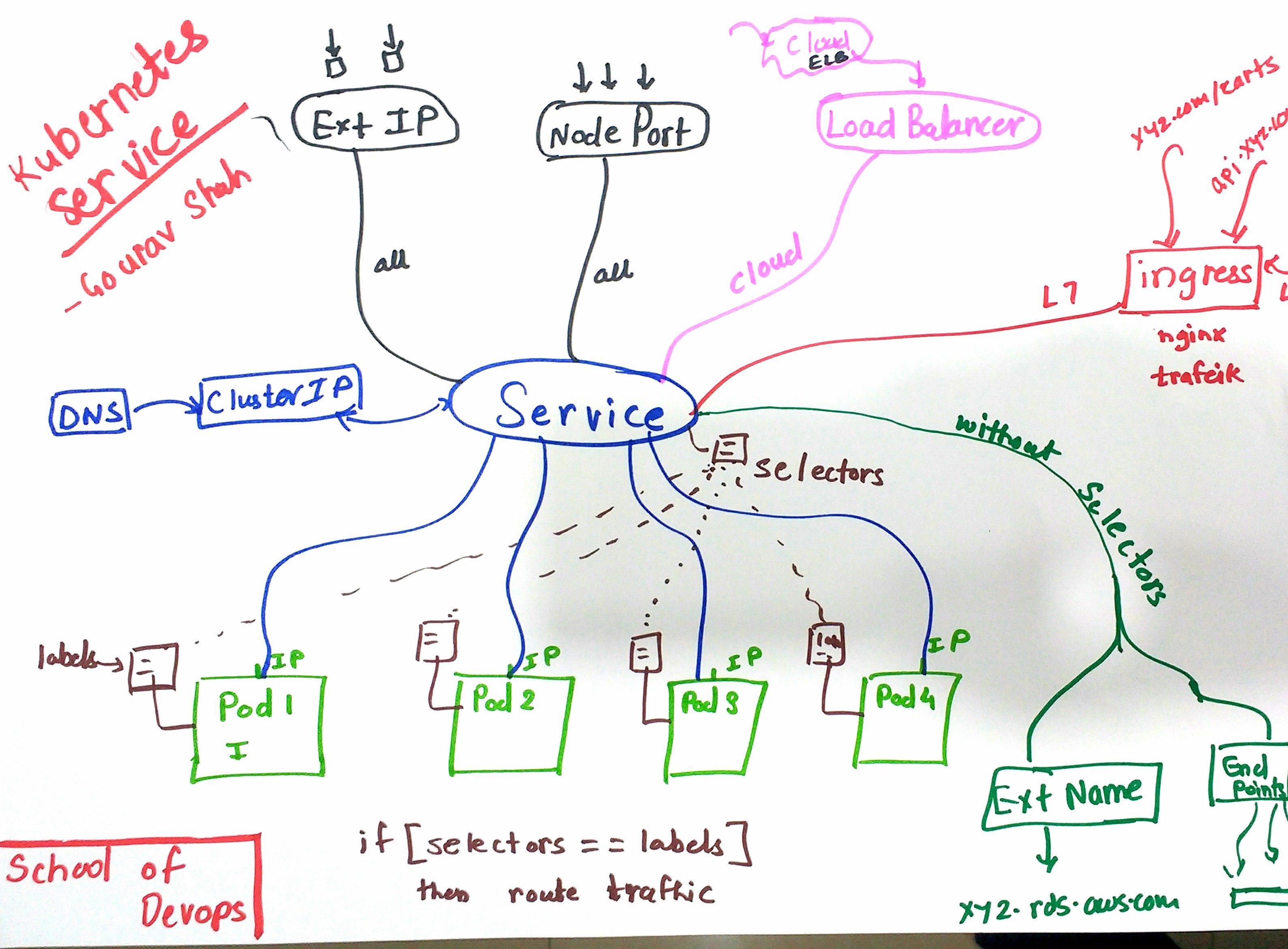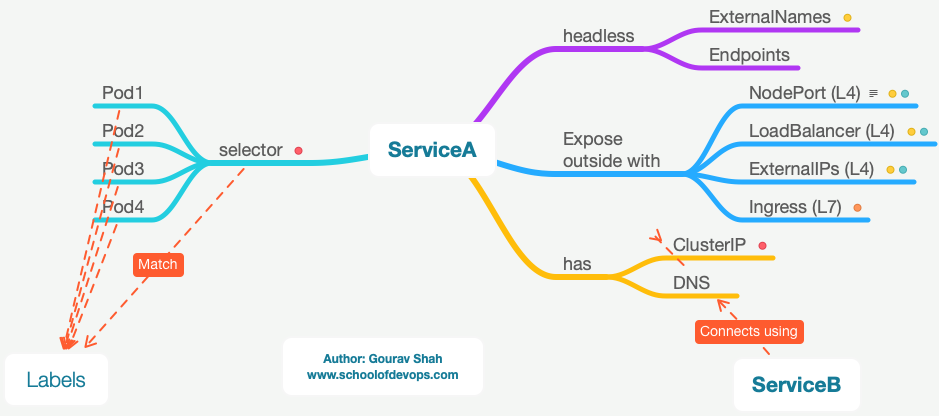Service Networking, Load Balancing and Service Discovery
In this lab, you would not only publish the application deployed with replicaset earlier, but also learn about the load balancing and service discovery features offered by kubernetes.
Concepts related to Kubernetes Services are depicted in the following diagram,


Publishing external facing app with NodePort
Kubernetes comes with four types of services viz.
- ClusterIP
- NodePort
- LoadBalancer
- ExternalName
Lets create a service of type NodePort to understand how it works.
To check the status of kubernetes objects,
kubectl get all
You could also start watching the above output for changes. To do so, open a separate terminal window and run,
watch kubectl get all
Refer to Service Specs to understand the properties that you could write.
filename: vote-svc.yaml
---
apiVersion: v1
kind: Service
metadata:
name: vote
labels:
role: vote
spec:
selector:
role: vote
ports:
- port: 80
targetPort: 80
nodePort: 30000
type: NodePort
Apply this file to to create a service
kubectl apply -f vote-svc.yaml --dry-run
kubectl apply -f vote-svc.yaml
kubectl get svc
kubectl describe service vote
[Sample Output of describe command]
Name: vote
Namespace: instavote
Labels: role=svc
tier=front
Annotations: kubectl.kubernetes.io/last-applied-configuration={"apiVersion":"v1","kind":"Service","metadata":{"annotations":{},"labels":{"role":"svc","tier":"front"},"name":"vote","namespace":"instavote"},"spec":{...
Selector: app=vote
Type: NodePort
IP: 10.108.108.157
Port: <unset> 80/TCP
TargetPort: 80/TCP
NodePort: <unset> 31429/TCP
Endpoints: 10.38.0.4:80,10.38.0.5:80,10.38.0.6:80 + 2 more...
Session Affinity: None
External Traffic Policy: Cluster
Events: <none>
Observe the following
- Selector
- TargetPort
- NodePort
- Endpoints
Go to browser and check http://HOSTIP:NODEPORT
Here the node port is 30000 (as defined by nodePort in service spec).
Sample output will be:

If you refresh the page, you should also notice its sending traffic to diffent pod each time, in round robin fashion.
Exercises
- Change the selector criteria to use a non existant label. Use
kubectl edit svc./voteto update and apply the configuration. Observe the output of describe command and check the endpoints. Do you see any ? How are selectors and pod labels related ? - Observe the number of endpoints. Then change the scale of replicas created by the replicasets. Does it have any effect on the number of endpoints ?
Services Under the Hood
Lets traverse the route of the network packet that comes in on port 30000 on any node in your cluster.
Connect to a node (If creatd using KIND) with,
docker exec -it --privileged kind-worker2 sh
and then check the IPTables config as,
iptables -nvL -t nat
iptables -nvL -t nat | grep 30000
Anything that comes on dpt:3000, gets forwarded to the chain created for that service.
iptables -nvL -t nat | grep KUBE-SVC-VIQHAVHDK4QE7NA4 -A 10
Chain KUBE-SVC-VIQHAVHDK4QE7NA4 (2 references)
pkts bytes target prot opt in out source destination
0 0 KUBE-SEP-RFJGHFMXUDJXIEW6 all -- * * 0.0.0.0/0 0.0.0.0/0 /* instavote/vote: */ statistic mode random probability 0.20000000019
0 0 KUBE-SEP-GBR5YQCVRYY3BA6U all -- * * 0.0.0.0/0 0.0.0.0/0 /* instavote/vote: */ statistic mode random probability 0.25000000000
0 0 KUBE-SEP-BAI3HQ7SV7RZ2CI6 all -- * * 0.0.0.0/0 0.0.0.0/0 /* instavote/vote: */ statistic mode random probability 0.33332999982
0 0 KUBE-SEP-2EQSLPEP3WDOTI5J all -- * * 0.0.0.0/0 0.0.0.0/0 /* instavote/vote: */ statistic mode random probability 0.50000000000
0 0 KUBE-SEP-2CJQISP4W7F2HCRW all -- * * 0.0.0.0/0 0.0.0.0/0 /* instavote/vote: */
Where,
- count of KUBE-SEP-xxx matches number of pods.
- KUBE-SEP-BAI3HQ7SV7RZ2CI6 is an example of a chain created for one of the hosts. Examine that next.
iptables -nvL -t nat | grep KUBE-SEP-BAI3HQ7SV7RZ2CI6 -A 3
[output]
pkts bytes target prot opt in out source destination
0 0 KUBE-MARK-MASQ all -- * * 10.32.0.6 0.0.0.0/0 /* instavote/vote: */
0 0 DNAT tcp -- * * 0.0.0.0/0 0.0.0.0/0 /* instavote/vote: */ tcp to:10.32.0.6:80
--
where the packet is being forwarded to 10.32.0.6, which should corraborate with the ip of the pod
e.g.
kubectl get pods -o wide
NAME READY STATUS RESTARTS AGE IP NODE
vote-58bpv 1/1 Running 0 1h 10.32.0.6 k-02
vote-986cl 1/1 Running 0 1h 10.38.0.5 k-03
vote-9rrfz 1/1 Running 0 1h 10.38.0.4 k-03
vote-dx8f4 1/1 Running 0 1h 10.32.0.4 k-02
vote-qxmfl 1/1 Running 0 1h 10.32.0.5 k-02
10.32.0.6 matches ip of vote-58bpv
to check how the packet is routed next use,
ip route show
[output]
default via 128.199.128.1 dev eth0 onlink
10.15.0.0/16 dev eth0 proto kernel scope link src 10.15.0.10
10.32.0.0/12 dev weave proto kernel scope link src 10.32.0.1
128.199.128.0/18 dev eth0 proto kernel scope link src 128.199.185.90
172.17.0.0/16 dev docker0 proto kernel scope link src 172.17.0.1 linkdown
where, 10.32.0.0/12 is going over weave interface.
Exposing a Service with ExternalIPs
Observe the output of service list, specifically note the EXTERNAL-IP colum in the output.
kubectl get svc
Now, update the service spec and add external IP configs. Pick IP addresses of any two nodes (You could add one or more) and it to the spec as,
kubectl edit svc vote
[sample file edit]
---
apiVersion: v1
kind: Service
metadata:
name: vote
labels:
role: vote
spec:
selector:
role: vote
ports:
- port: 80
targetPort: 80
nodePort: 30000
type: NodePort
externalIPs:
- xx.xx.xx.xx
- yy.yy.yy.yy
Where
replace xx.xx.xx.xx and yy.yy.yy.yy with IP addresses of the nodes on two of the kubernetes hosts.
apply
kubectl get svc
kubectl apply -f vote-svc.yaml
kubectl get svc
kubectl describe svc vote
[sample output]
NAME TYPE CLUSTER-IP EXTERNAL-IP PORT(S) AGE
vote NodePort 10.107.71.204 206.189.150.190,159.65.8.227 80:30000/TCP 11m
where,
EXTERNAL-IP column shows which IPs the application is been exposed on. You could go to http://
Internal Service Discovery
Kubernetes not only allows you to publish external facing apps with the services, but also allows you to discover other components of your application stack with the clusterIP and DNS attached to it.
Before you begin adding service discovery,
- Visit the vote app from browser
- Attempt to vote by clicking on one of the options
observe what happens. Does it go through?
Debugging,
kubectl get pod
kubectl exec vote-xxxx nslookup redis
[replace xxxx with the actual pod id of one of the vote pods ]
keep the above command on a watch. You should create a new terminal to run the watch command.
e.g.
kubectl exec -it vote-xxxx sh
watch kubectl exec vote-xxxx ping redis
where, vote-xxxx is one of the vote pods that I am running. Replace this with the actual pod id.
Now create redis service
kubectl apply -f redis-svc.yaml
kubectl get svc
kubectl describe svc redis
Watch the nslookup screen and observe if its able to resolve redis by hostname and its pointing to an IP address.
e.g.
Name: redis
Address 1: 10.104.111.173 redis.instavote.svc.cluster.local
where
- 10.104.111.173 is the ClusterIP assigned to redis service
- redis.instavote.svc.cluster.local is the dns attached to the ClusterIP above
What happened here?
- Service redis was created with a ClusterIP e.g. 10.102.77.6
- A DNS entry was created for this service. The fqdn of the service is redis.instavote.svc.cluster.local and it takes the form of my-svc.my-namespace.svc.cluster.local
- Each pod points to internal DNS server running in the cluster. You could see the details of this by running the following commands
kubectl exec vote-xxxx cat /etc/resolv.conf
[replace vote-xxxx with actual pod id]
[sample output]
nameserver 10.96.0.10
search instavote.svc.cluster.local svc.cluster.local cluster.local
options ndots:5
where 10.96.0.10 is the ClusterIP assigned to the DNS service. You could co relate that with,
kubectl get svc -n kube-system
NAME TYPE CLUSTER-IP EXTERNAL-IP PORT(S) AGE
kube-dns ClusterIP 10.96.0.10 <none> 53/UDP,53/TCP 1h
kubernetes-dashboard NodePort 10.104.42.73 <none> 80:31000/TCP 23m
where, 10.96.0.10 is the ClusterIP assigned to kube-dns and matches the configuration in /etc/resolv.conf above.
Creating Endpoints for Redis
Service is been created, but you still need to launch the actual pods running redis application.
Create the endpoints now,
kubectl apply -f redis-deploy.yaml
kubectl describe svc redis
[sample output]
Name: redis
Namespace: instavote
Labels: role=redis
tier=back
Annotations: kubectl.kubernetes.io/last-applied-configuration={"apiVersion":"v1","kind":"Service","metadata":{"annotations":{},"labels":{"role":"redis","tier":"back"},"name":"redis","namespace":"instavote"},"spec"...
Selector: app=redis
Type: ClusterIP
IP: 10.102.77.6
Port: <unset> 6379/TCP
TargetPort: 6379/TCP
Endpoints: 10.32.0.6:6379,10.46.0.6:6379
Session Affinity: None
Events: <none>
Again, visit the vote app from browser, attempt to register your vote. observe what happens. This time the vote should be registered successfully.
Summary
In this lab, you have published a front facing application, learnt how services are implemented under the hood as well as added service discovery to provide connection strings automatically.